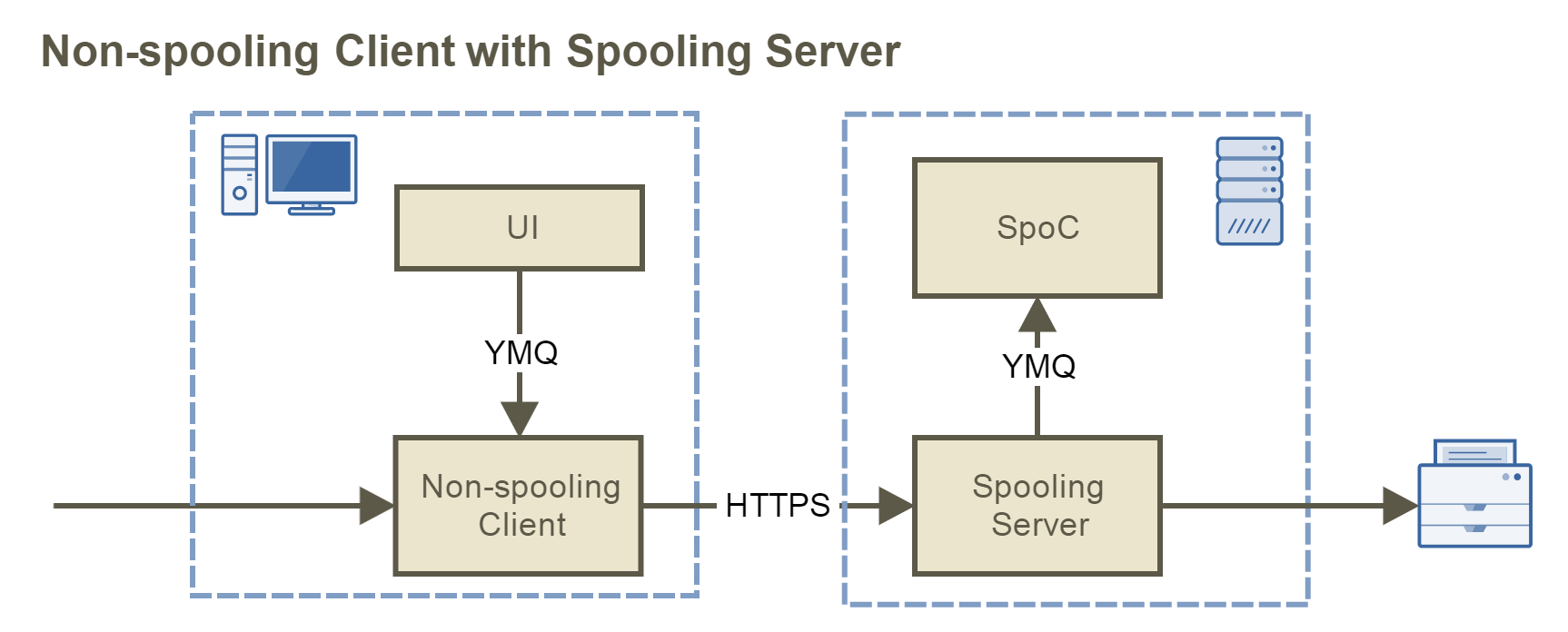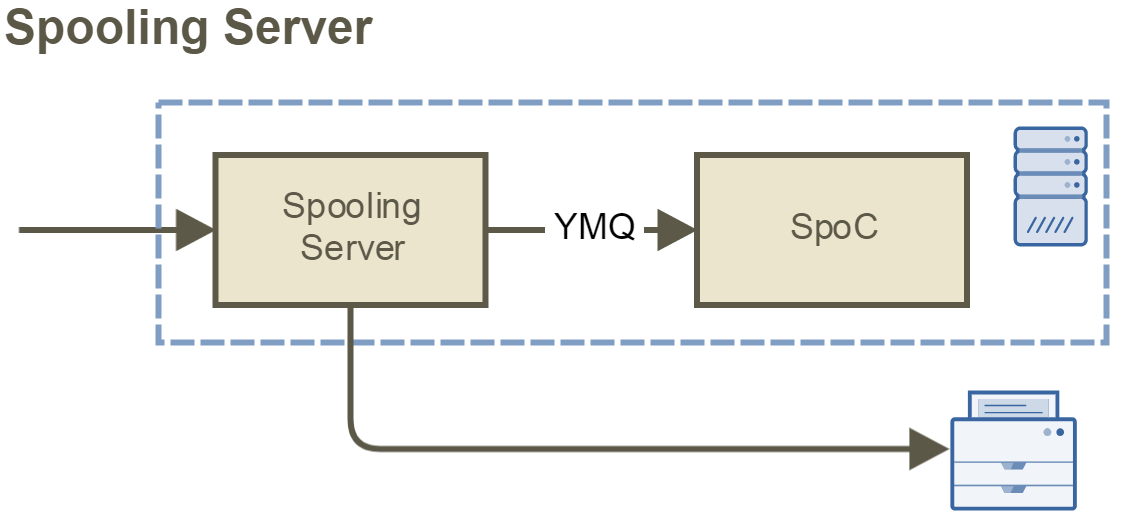Configuring YSoft SafeQ FlexiSpooler Modes
Overview
This page describes available YSoft SafeQ FlexiSpooler modes and how they work together.
Each mode is one possible configuration of a connection to YSoft SafeQ Spooler Controller or a different FlexiSpooler and YSoft SafeQ printer. It is set up during installation as a choice when combining these two options:
Enable or disable spooling (Spooling here means saving incoming print jobs into configurable folder named JobStore.)
Client or server (Client has always a user interface called YSoft SafeQ Desktop Interface)
Modes can also be set manually after installation. See FlexiSpooler locations configuration with locations.config file
To configure repository where incoming print jobs are saved, see FlexiSpooler local configuration through spooler.config file
We recommend to stop YSoft SafeQ FlexiSpooler service and YSoft SafeQ Desktop Interface service before change is made, then start them again.
Describing Modes
There are cases when the local spooling (saving) of print jobs is not desirable. In these situations, print jobs are forwarded to another FlexiSpooler that handles them. FlexiSpooler uses HTTPS (by default; it can be changed in spooler.config to HTTP) for job and request forwarding.
A print job is always analyzed by the first FlexiSpooler, who receives it regardless of its mode. The last FlexiSpooler in a row is always spooling (that means it will save the print jobs) and it will send the job tickets to a Spooler Controller.
1. Spooling client mode (typical CBPR scenario)
Provides user interface (YSoft SafeQ Desktop Interface) which communicates with FlexiSpooler via YMQ.
As it starts, FlexiSpooler service (whether after restart, during installation or update) attempts to launch Desktop Interfaces for all the logged in users, see chapter YSoft SafeQ 6 Workstation Installation, section Automatic launching of Desktop Interfaces from FlexiSpooler service at start..
Print jobs are received only on localhost (127.0.0.1).
Print jobs are both analyzed and saved on a local computer.
Spooling client mode is connected directly to Spooler Controller via YMQ.
Print jobs are sent from client directly to MFD when printing.
That means that the client workstation must be available in the time when user wants to print on a device or job replication feature must be turn on and configured.

2. Non-spooling client mode
Provides user interface (YSoft SafeQ Desktop Interface) which communicates with FlexiSpooler via YMQ.
As it starts, FlexiSpooler service (whether after restart, during installation or update) attempts to launch Desktop Interfaces for all the logged in users, see chapter YSoft SafeQ 6 Workstation Installation, section Automatic launching of Desktop Interfaces from FlexiSpooler service at start..
Print jobs are received only on localhost (127.0.0.1).
Print jobs are analyzed on a local computer and then sent to spooling server, which spools the job.
Non-spooling client is connected to spooling server via HTTP/HTTPS.
Print jobs are sent from spooling server directly to MFD when printing.
Limitations
Desktop Interface cannot display RBE notifications in this mode.
The offline print feature does not work in non-spooling client mode.

Non-spooling clients could be connected to non-spooling server. Print job is analyzed on the client:

3. Spooling server mode
Print jobs are received on all interfaces on server (list of the interfaces could be defined in configuration).
Print jobs are analyzed and saved on a server (where FlexiSpooler in spooling server mode is installed).
Servers with installed FlexiSpoolers in spooling server mode are used for Far roaming, it is not possible to use this feature without it. (For Near roaming to work you do not need any FlexiSpooler installed on site servers, only SPOC . But there may be limitations on other functionality, e.g. only FlexiSpooler in spooling server mode can receive print jobs from SafeQ Enterprise Client 2.x)
Spooling server communicates with Spooler Controller via YMQ.
Print jobs are sent from spooling server directly to MFP when printing.
Spooling server can receive print jobs from SafeQ Enterprise Client 2.x (SQ4/SQ5) (see How to set receiving print jobs from YSoft SafeQ Client Enterprise 2.x via port 9100).
Limitations
FSP Spooling Server must be deployed with SPOC.

4. Non-spooling server mode
A non-spooling server was established for scenarios where users need to connect from an unsafe environment to YSoft SafeQ via Microsoft Azure or DMZ. In fact, it is a kind of smart proxy for communication between the destination spooling server and a non-spooling client.
Print jobs are received on all interfaces on server (list of the interfaces could be defined in configuration).
Print jobs are analyzed on a non-spooling server and then sent to FlexiSpooler in spooling server mode.
Non-spooling server can be installed on a different computer than Spooler Controller.
FlexiSpooler in non-spooling server mode has to be connected to FlexiSpooler in spooling server mode.
Communication between all FlexiSpoolers are done via HTTP/HTTPS. Last spooling node is connected to Spooler Controller via YMQ.
Print jobs are sent from spooling server directly to MFD when printing.

Q&A
Q: What are differences between a spooling and non-spooling client?
A: A spooling client saves print jobs locally, but a non-spooling client sends it to a spooling server–where they are saved. Therefore, a spooling client does not need a server mode, but a non-spooling client needs to connect to FlexiSpooler in server mode.
Q: Is Far Roaming supported by FlexiSpooler?
A: Yes, but there is a limitation: For Far Roaming to work, every SPOC needs to have FSP server on the same machine.